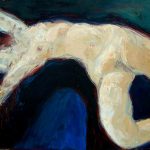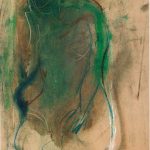AN INTERNATIONAL JOURNAL OF CHINESE & ENGLISH-LANGUAGE POETRY
Because of the Wind
Paintings & Drawings © Yang Wei-chung
 Born in Hualein, Taiwan in 1947, Yang Wei-chung studied painting under Chen Ching-hui, and at 19 was the youngest artist selected for the Tai-yang Fine Arts Exhibition. In 1972, he studied oil painting and drawing at the Univ. of Washington, and later at the Cornish School of Allied Arts, both in Seattle. His first solo exhibition was at Seattle’s Moldrem Gallery.
Born in Hualein, Taiwan in 1947, Yang Wei-chung studied painting under Chen Ching-hui, and at 19 was the youngest artist selected for the Tai-yang Fine Arts Exhibition. In 1972, he studied oil painting and drawing at the Univ. of Washington, and later at the Cornish School of Allied Arts, both in Seattle. His first solo exhibition was at Seattle’s Moldrem Gallery.
Among his awards are the Taiwan Fine Arts Association’s Golden Cup, and Hualien County’s Passing the Torch prize for oil painting. Featured in more than a dozen solo exhibitions, including two at the Tamsui Center of Arts and Culture in 1998 and 2001, Yang’s art has also appeared in at least fifty group shows across Taiwan. Since 1963, the artist has lived with his family and maintained a studio in Tamsui, just north of Taipei.
楊維中,1947年出生於臺灣花蓮,早年入淡江中學美術科學習繪畫,得畫家陳敬輝老師啓蒙,19歲首次參加並入選「臺陽美展」。為進一步拓展藝術視野及技巧,1972年隨美國華盛頓州立大學邁可·達利(Michael Dailey)教授及西雅圖科尼西藝術學校歐文教授研習油畫及素描,並於1974年在西雅圖Moldrem畫廊舉辦首次個展。
曾獲中華民國畫學會頒贈「金爵獎」,花蓮縣「油畫薪傳獎」,擔任過淡江高級中學教師、中國美術協會會員及中華民國畫學會會員,在臺灣和美國多家畫廊、藝術館舉辦過十數次個展,包括1998及2001年兩度在淡水藝文中心舉行個展,並應邀參加國內外聯展50餘次。1963年定居淡水,專事繪畫創作。
Note
Unless skilled in the source language, most readers encounter the words of foreign writers through translation. But visual art may cross borders with relative ease, depending on universality of theme and depiction. The most powerful art and writing retains its strength and currency by conveying persistent truths and beauties, however defined, however mediated. Klimt or Li Bai still move us, Gauguin or Wang Wei. East or west, such art tends to the omnivorous, taking what it needs wherever found, recasting toward new vision. Since the early 20th c., and especially postwar, many American poets have been informed by and indebted to translated classical Chinese and Japanese poetry. In Yang Wei-chung’s painting, we explore an intuited world, graced by a fruitful harmony with Impressionists or Fauvists such as Rouault, Dufy, Matisse, or Signac. These affinities are natural, his art’s chordal notes. Deep blues, sun-flecked groves, warm terracottas, cubes of houses, sharp-wedged light. Some of his paintings are partly representational, others fairly abstract. Yet Yang’s art remains nonetheless his own, wrought and enriched by his surround, whether the east coast of Taiwan where he grew up, the north coast mountains above Taipei, or an inner realm of pure shape and color. Like his late brother, the eminent Taiwan poet Yang Mu, also featured in this issue, Yang Wei-cheng draws sustenance wherever he looks.
若非熟悉掌握母語之外的其他語言,大多數讀者需通過翻譯作品與外國作家邂逅。在這一方面,繪畫的語言門檻似乎相對容易跨過,單看繪畫內容與主題的普適程度。拋開手法和媒介的差異,無論藝術創作抑或寫作,其至高境界在於不懈追求真與美,以達成作品的力量和經久性。也因此,克里姆特和李白同樣吸引我們,高更和王維亦同樣動人。這樣的作品往往是雜食性的,它從不同時空吸取所需養分,不斷鑄就新的視野,不受東西方背景約束。自20世紀初始,尤其在二戰之後,眾多美國詩人便深受中國與日本古典詩歌的啓發和惠澤。如若直觀探索楊維中的繪畫世界,其中亦優雅地平衡著印象派、野獸派等畫派的累累果實,讓人聯想起魯奧、杜菲、馬蒂斯、西涅克。這是自然的聯姻,也是他個人藝術的和弦。深邃的藍,日光點點的樹林,溫暖的屋瓦,立體的房子,楔形的光線。有的半透輪廓,有的萬般抽象。然而楊維中的藝術擁有獨特風貌,為他自身的經驗所刻畫和豐富,取材對象包括臺灣東海岸的成長,北海岸的山色,以及他內心世界純粹的線條和色彩。與他的胞兄、臺灣詩人楊牧一樣,他們的眼光所到之處即是創作源泉。





























